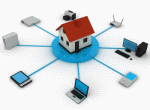
Don't Leave Your Cyber Door Open to Intruders
You've installed every security device you can think of to keep your home as safe as possible. You have alarms, closed circuit video cameras and the whole shebang. No one is getting in! Except, there is just one problem! You've left a door wide open for thieves, and you probably don't even know it. Any thief can get access to your bank account, passwords, credit cards and any other personal information he wants - and to top it all off - he doesn't even have to set foot in your house. He can get in through your Internet connection if you have left it unsecured.
The Unsecured Home Network is Like Having a Public Open Network Always Available to Anyone
An insecure home network is much like a public open network, meaning anyone can get on it, and hackers can view all the computers on any network, access them just as a pick pocket can access your wallet; once inside the network all a hacker has to do is wait to see what websites you visit and watch for you to input your bank information, credit card data, personal information, etc. I think you get my drift. The following are 3 great tips that can better secure your home Internet network, and keep it safe from intruders.
Encryption Matters
Enable Encryption on your Internet modem or router, which is usually supplied by your ISP provider. Most wireless modems or routers have the encryption feature disabled by default. You can enable WPA or WPA2 encryption, which will scramble your signal and prevent any unauthorized user from accessing it. To do this you need to access the utility webpage for your modem or router model (usually included in the installation instructions). Click on the "Wireless" option and select "Wireless Security," and select the encryption enable option. Give the process a password you will always remember.
- WPA encryption is the preferred wireless security encryption method and is more secure than WEP. Most laptops support this method.
- WPA2 is the latest encryption method and the best option if your laptop supports this method.
Is your SSID Guessable?
Select a different Service Set Identifier (SSID) than the one that comes standard with the modem or router. This is the name you give your wireless connection. When you click the wireless available connections in the bottom right hand task bar, you'll see a list of available connections. Most of these have specific names. When you give your connection a specific name, instead of the standard modem model number, then you discourage hackers by letting them know that you are aware of the protection issues and have taken steps to protect your wireless network.
To change the SSID name, enter the modem or router utility webpage using the instructions offered in the modem or router instructional booklet. Look for the "Wireless" option, and select "Basic Wireless Settings" or a similar command. Then locate the option allowing you to change the Wireless Network Name (SSID), and follow the on-screen instructions.
Eliminate the SSID broadcasting
To protect your network even further, prevent the modem or router from broadcasting your network as being available. To do this you have to command the router or modem to stop broadcasting your network name to everybody. If you later want to give your network access to someone, you have to give them the name you chose. To disable this feature, locate the "Wireless Settings" options and click on the button next to "Wireless SSID broadcast."
These are safe ways you can make your Internet network safer and keep others from finding out what your specific computer and network Internet Protocol address is; and keep hackers from infiltrating your privacy.
Guest post contributed by Christian Westerberg on behalf of HomeInsurance.com. Christian is a freelance tech writer. He enjoys sharing his tips and insights on various blogs.

